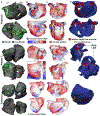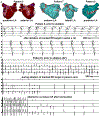Computationally guided personalized targeted ablation of persistent atrial fibrillation
- PMID: 31427780
- PMCID: PMC6842421
- DOI: 10.1038/s41551-019-0437-9
Computationally guided personalized targeted ablation of persistent atrial fibrillation
Abstract
Atrial fibrillation (AF)-the most common arrhythmia-significantly increases the risk of stroke and heart failure. Although catheter ablation can restore normal heart rhythms, patients with persistent AF who develop atrial fibrosis often undergo multiple failed ablations, and thus increased procedural risks. Here, we present personalized computational modelling for the reliable predetermination of ablation targets, which are then used to guide the ablation procedure in patients with persistent AF and atrial fibrosis. First, we show that a computational model of the atria of patients identifies fibrotic tissue that, if ablated, will not sustain AF. Then, we report the results of integrating the target ablation sites in a clinical mapping system and testing its feasibility in ten patients with persistent AF. The computational prediction of ablation targets avoids lengthy electrical mapping and could improve the accuracy and efficacy of targeted AF ablation in patients while eliminating the need for repeat procedures.
Figures




References
-
- Andrade J, Khairy P, Dobrev D & Nattel S The clinical profile and pathophysiology of atrial fibrillation: relationships among clinical features, epidemiology, and mechanisms. Circ Res 114, 1453–1468 (2014). - PubMed
-
- Go AS et al. Prevalence of diagnosed atrial fibrillation in adults: national implications for rhythm management and stroke prevention: the AnTicoagulation and Risk Factors in Atrial Fibrillation (ATRIA) Study. JAMA 285, 2370–2375 (2001). - PubMed
-
- Dorian P et al. The impairment of health-related quality of life in patients with intermittent atrial fibrillation: implications for the assessment of investigational therapy. J Am Coll Cardiol 36, 1303–1309 (2000). - PubMed
Publication types
MeSH terms
Grants and funding
LinkOut - more resources
Full Text Sources
Other Literature Sources
Medical

